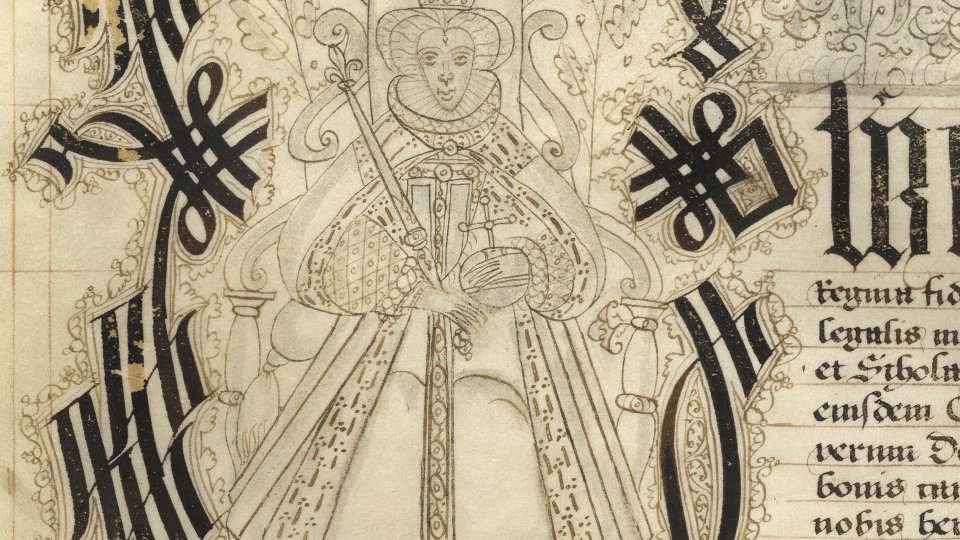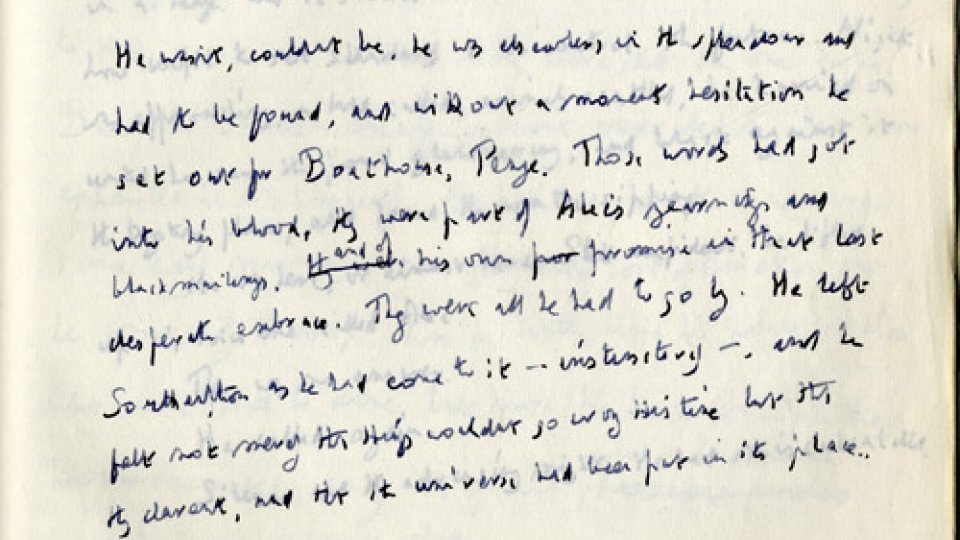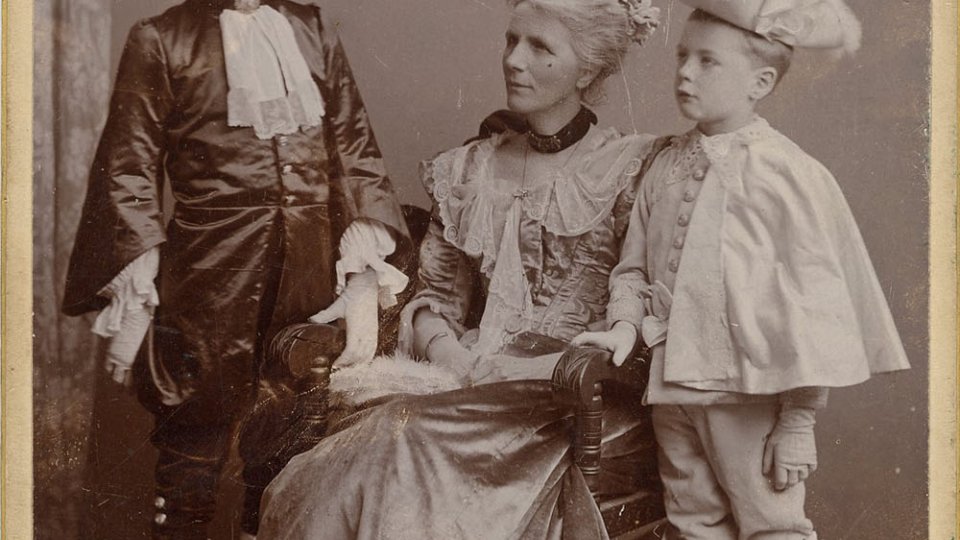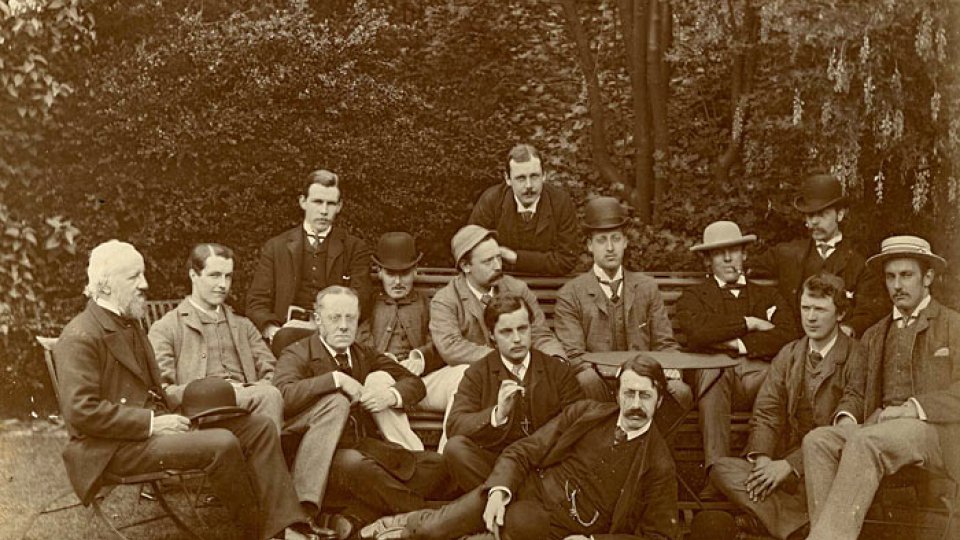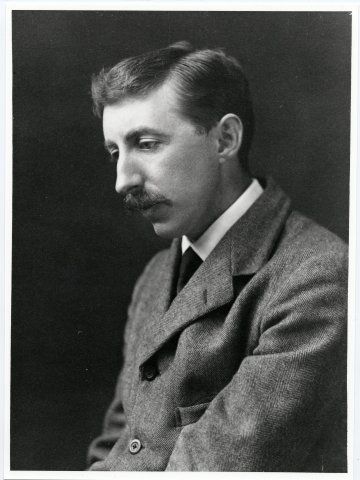
This exhibition will give a roughly chronological overview of E.M. Forster's life, with particular reference to people and places which influenced his most famous writings.
The order of publication of his novels (see below) did not always reflect that in which he wrote them. His final novel, Maurice, was published posthumously.
| Year | Novel title |
|---|---|
| 1905 | Where Angels Fear to Tread |
| 1907 | The Longest Journey |
| 1908 | A Room with a View |
| 1910 | Howards End |
| 1924 | A Passage to India |
| 1970 | Maurice |
Maurice will not be included in this exhibition, as there is a separate Archive of the Month ('Friend's: Forster's Confidants', May 2014) on that novel. To see that feature, please follow the link at the bottom of this page.
Edward Morgan Forster was born on 1 January 1879 at 6 Melcombe Place. He was the only child of Edward (Eddie) Morgan Llewellyn Forster (1847-1880) and Alice Clara (Lily) Whichelo (1855-1945). Forster’s father, an architect, died when he was an infant. The widow and her son spent the next two years living in the houses of friends and relations in London and Bournemouth.
In 1883 they moved to Rooksnest near Stevenage in Hertfordshire where they lived for ten years until their lease was not renewed. It was a house for which E.M. Forster held great affection throughout his life, and became the model for the home in his novel 'Howards End'.
In 1890, Forster was sent to board at Kent House, a preparatory school in Eastbourne.
Upon leaving Rooksnest, in September 1893, they rented ‘Dryhurst’ in Tonbridge, where he became a day boy at the public school.
Marianne Thornton, Eddie’s aunt, was so influential on Forster, particularly during his childhood, that his final book was a biography of her.
After a number of unhappy years in public schools, Forster came up to King's in 1897 to read Classics. His tutor, Nathaniel Wedd, was of some influence on the young Forster, encouraging him to become a writer and more generally being responsible, according to Forster, for "such awakening as has befallen me".
He received a B.A. in 1900. Forster stayed on for a fourth year to read history, being tutored in this capacity by Oscar Browning, and at the same time came under the influence of Goldsworthy Lowes Dickinson, who became a lifelong friend.
It was in his fourth year that his friend Hugh Meredith sponsored Forster to become a member of the secret University debating society called the Apostles. After graduating he became an 'angel' and continued to be active in the society. Influential Apostles at the time included such Kingsmen as the art critic Roger Fry and the economist Maynard Keynes (both angels – members who have graduated) and the poet Rupert Brooke (an undergraduate at the time).
Forster's novel’s are full of references to music. Like Lucy (A Room with a View), he could play piano. In his undergraduate diary for 1898, Forster mentions a luncheon followed by playing Schubert with Oscar Browning, saying that "he and I played Schubert to the delight of the others. There was a report that the Dead March was to be played in chapel, which was accordingly crammed, but nothing happened."
Despite obvious talents (he received prizes for Classics and English), Forster received a second class degree. This led to uncertainty about what career he should enter. A legacy from his great-aunt allowed Forster to travel extensively from 1901. His travels informed his writing, and he often travelled with other Cambridge and King's companions.
He travelled to Florence with his mother at the end of October 1901, staying at the Pension Simi, then 2 lungarno alle Grazie. While in Rome, that December, he started to write A Room with a View, after abandoning a novel he had started as an undergraduate, called ‘Nottingham Lace’. His journey then continued to Austria before he returned to London in October 1902. After this, he gave lectures and worked on an edition of Aeneid.
Forster and some of his fellow Kingsmen travelled to Greece the following year.
In 1904 Forster and his mother moved to Harnham in Weybridge, where they lived for the next 20 years.
Musicologist Edward Dent (KC 1895) was the inspiration for Philip Herriton in Forster's Where Angels Fear to Tread, as well as being Forster's guide in all matters Italian, and many matters musical.
In spring 1905, Forster went to Nassenheide, in Germany, to teach the writer Elizabeth von Arnim’s children. That summer, he had pieces published in the Independent Review and Where Angels Fear to Tread became his first novel to be published.
In 1906, Forster taught Syed Ross Masood, who was waiting to go up to Oxford, Latin. Furbank, Forster’s biographer, notes "Masood, Forster was to say later, woke him out of his suburban and academic life and showed him new horizons and a new civilization… he fell in love with Masood".
In 1907, Forster went on a walking tour of Wales, with the Merediths, George and Florence Barger. Florence was to become one of Forster’s closest friends.
Despite his travels, Forster returned to his undergraduate experiences, including as a member of the Apostles, for inspiration towards his second novel, The Longest Journey.
A Room with a View (1908) was the third of Forster’s novels to be published, despite it being the one he started first. He started a novel based on his experiences as a traveller in Italy during his first visit there with his mother in 1901-2, shortly after graduating from King’s. Drafts survive in manuscript of two attempts at the novel, one later called by Forster ‘Old Lucy’ and the second, inevitably, ‘New Lucy.’ One draft was set entirely in Italy, the other in England, though they shared some of the same characters. The finished novel brings the plots together and is set partly in Italy, partly in England. But neither of the early drafts is very close to the finished A Room with a View.
Some of the characters in A Room with a View were based on Forster’s friends and family. Hugh Owen Meredith (H.O.M., to whom the novel was dedicated) inspired the character George, the rescuer of Lucy from muddle and self-deception. Mrs. Honeychurch was inspired by Forster’s grandmother Louisa Whichelo.
There are various points in the novel in which art imitates life….
The Cockney Signorina presided over the Bertolini resembles the lady who ran the Pensione Simi, visited by the Forsters.
In a letter Forster wrote to Dent in 1901, he said "We have been here three days, and are very comfortable, but my mother hankers after an Arno view and a South aspect, so we are not stopping".
While working as a tutor to the children of Elizabeth von Arnim, at Nassenheide, Forster had a short holiday and recorded in his travel journal that he had seen "the most beautiful things: bathers running naked under sun pierced foliage…".
This may have inspired the scene in chapter 12 of A Room with a View (drafted in this same notebook) where the Reverend Beebe, George Emerson and Freddy similarly run naked after bathing in the 'Sacred Lake'.
Another example of Forster’s art imitating his life is the big “?” at the end of his 1910 birthday/New Year review. Forster was in some distress about how another man reacted to a letter he had sent. This echoes the ‘note of interrogation’ left by young Emerson in the fictional room with a view. The youth’s father later asked Lucy to befriend the young man who is distressed over the fact "that all life is perhaps a knot…why should this make us unhappy? Let us rather love one another".
Forster was highly critical of his own writing, including this very popular novel. In a letter to his old tutor Nathaniel Wedd, Forster was very diffident about A Room with a View, calling it "slight, unambitious, and uninteresting, but - in rather an external way - the characters seem more alive to me than any others I have put together".
Perhaps he felt the book would disappoint Wedd, who encouraged him to write and whose opinion he valued so highly.
If his previous novels were inspired by his travels and his life experiences, one might argue that the inspiration behind his fourth published novel, Howards End (1910) was more domestic. For the eponymous house in his novel, he took inspiration from Rooksnest.
In his Commonplace Book, Forster assessed his novels, rating Howards End highest, but despite the significance of the Schlegel sisters, he also stated that Lucy in A Room with a View is the only female character he likes.
The travels which had so informed Forster’s early novels were within Europe, prinicipally Italy and Greece. After Howards End, he travelled further afield. His writing tended to focus on short stories and non-fiction.
Forster first visited India in 1912-13 in the company of fellow Apostles Robert Trevelyan (Trinity College, 1891, whom he had previously met up with during travels in Italy with his mother), Goldsworthy Lowes Dickinson, and Malcolm Darling (KC 1899, a rising star in the Indian Civil Service).
In 1912, he travelled to India for the first time, keeping a diary. He recorded his arrival in Bombay, describing it as “a queer red series of hills a little disquieting, as though Italy had been touched into the sinister”.
On the opposite page to that, he described Bombay more fully.
“The English have built it and filled it with modern toys, and have gone away leaving the Indians to play there. Trams, Gothic architecture, Army and Navy stores.”
Initially, he stayed with the Masood family, before travelling the country. Nicola Beauman suggests that he first encountered the real Anglo-India in Lahore, and he was appalled by the English Club in Lahore. Bankipore was later to provide the inspiration for Chandrapore in A Passage to India.
Despite his objections to violence, Forster worked for the Red Cross in Alexandria during the First World War for three years from November 1915. In a letter to his mother he described the view from Montazah as suggesting “for the first time that I was in Africa, i.e. the Africa of romance and pirates and shipwrecked heroines”.
In addition to his work for the Red Cross, he also wrote a guide book to Alexandria, which was published in 1922. He returned to England in January 1919.
In 1921 Darling arranged for Forster to return to India for nine months as the Private Secretary to His Highness the Maharajah of Dewas State Senior.
When Forster’s Aunt Laura Forster died in 1924 she left him the leasehold of West Hackhurst in Abinger Hammer, Surrey, and they finally gave up Weybridge in January 1925. West Hackhurst had been designed by his father and was originally known as ‘Laura Lodge’.
He had a Bloomsbury pied-a-terre 1925-30 and moved to Brunswick Square for 1930-9, and a Chiswick flat that he had at least in 1945.
Forster met one of his closest friends, a policeman Bob Buckingham, at a party at J.R. Ackerley’s house in Hammersmith, in April 1930.
In 1945 Forster made his final trip to India, to address the all-India P.E.N. (poets, playwrights, editors, essayists and novelists) Club.
In December that year (the year his mother died) when Forster returned from India he was told – two days before his 65th birthday – that he must vacate West Hackhurst, as the owners required the land for their own use.
King's offered him an Honorary Fellowship from that time forward, and he split his time thereafter between a flat in London and rooms in Cambridge. In 1953 he returned to King's College, staying briefly with L.P. Wilkinson before residing in College, where he either taught little or not at all, held no college office, nor sat on any committee, but nevertheless came to know and influence a large number of undergraduates, acting as the sort of 'bachelor don' that had disappeared since his own days as an undergraduate.
E.M. Forster died at the house of Bob Buckingham and his wife, in Coventry, on 7 June 1970, at the age of 91.
Forster’s fame was not to diminish after his death. His novels have been published in numerous editions, in various languages; Maurice was published posthumously, in accordance with Forster’s wishes; and turned into films by Merchant Ivory.
